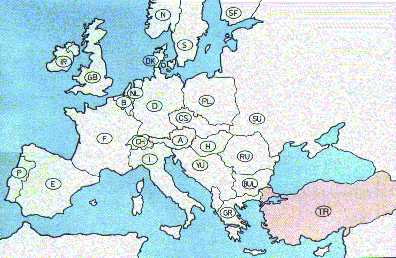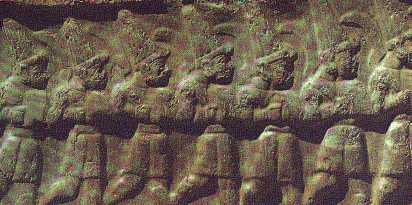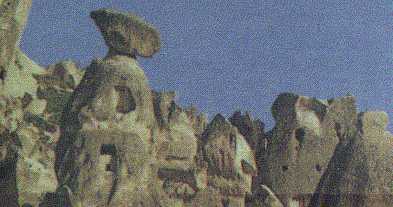
|
TURKIYE (TURKEY) |
|
Troy | Canakkale | Gallipoli Wars | History in Depths | Nusret | Edirne | Turkiye | Ataturk |

Europe and Asia meet in Turkiye. The Bosphorus strait divides the two and provides the vital link from Russia's Black Sea ports to the Mediterranean and beyond. On Turkiye's borders are Greece, Bulgaria, Russia, Iran, Iraq and Syria nearly 780,OOO square kilometers in area. Turkiye is surrounded on three sides by sea and covered for two-thirds by mountains. Highest of these is mighty Mount Ararat on whose 5165 meter summit Noah's Ark came to rest.
![]() Turkiye's climate varies widely. The Anatolia plateau, which forms the
bulk of Turkiye, is hot in summer and cold in winter. The Black Sea coast is
mild and damp, and the Mediterranean coast is warm and sunny. Turkiye forms a
natural land bridge between East and West. Across it have marched armies of numerous
invaders, leaving behind them the silt of man races and cultures.
Turkiye's climate varies widely. The Anatolia plateau, which forms the
bulk of Turkiye, is hot in summer and cold in winter. The Black Sea coast is
mild and damp, and the Mediterranean coast is warm and sunny. Turkiye forms a
natural land bridge between East and West. Across it have marched armies of numerous
invaders, leaving behind them the silt of man races and cultures.

The Hittite's established a great empire in Anatolia, 5000 years ago, which rivaled Mesopotamia, the birth place of civilization. The fall of legendary Troy gave the ancient Greeks their first foothold in Anatolia, after them came the Phrygians the Lydians and the Persians, followed by Alexander the Great. After his death Anatolia was incorporated into the Roman, and later the Byzantine Empires. Finally, from the central Asian sea of grass came the Turks. Under two dynasties, the Seljuks and the Ottomans, they established Farflug empires which lasted for nearly nine hundred years. The final blow came at the hands of the Turks themselves, when in 1923 Kemal Ataturk proclaimed the new Turkish Republic and laid the foundation of modern Turkiye.The brief history of Turkiye is in here.
The Turks of today, like their past are a mixture of East and West, Asia and Europe. The origins of their language lie in the Steppes of Asia, where the Orkhon inscriptions of the 7 th century provide the earliest record of Turkish. When the Turks embraced Islam in the 10 th century, they also adapted the Arabic script as being that in which the Moslem book The holly Koran, was revealed by God to his prophet Mohammed.
In 1928 in his drive towards westernization, Ataturk decreed the Turks should use the Latin alphabet. He toured the country with blackboard and chalk teaching it... Ataturk replaced the Islamic canon law with the Swiss civil law, banned polygamy and forbade women to wear the veil.
Turkiye has a mixed economy within which the public and private sectors co-exist.

Istanbul surrounded by agarland of waters its skyline shaped by 400 mosques is Turkiye's largest city and business center. It is the only city in the world located on two continents.. Linked across the Bosphorus by a mile long suspension bridge the longest in Europe. Many tourists have come to Turkiye since Noah. Two of the Seven Wonders of the ancient world - the Mausoleum at Halicarnassus and the Temple of Diana at Ephesus. Little of these wonders remain, but with the ruins of 12 great civilizations the whole of Turkiye is one vast open air museum: The prehistorical wall paintings of Catal Hoyuk, the ruined Lydian Capital at Sardis, the Byzantine chapels of Cappadoccia,

the Roman theatre at Aspendos. The oldest functioning building in the world, the 1400 years old St. Sophia, is in Istanbul, Turkiye. Many other things that you heard of but may be not connected to Turkiye such as:
Goreme valley (valley of fantastic) has more than 3OO churches carved out of rock caves in Turkiye. In half a day you can see half a dozen crusaders castles in Turkiye. Diogenes was born in Turkiye. Marco Polo set off for Cathay from Turkiye. The last home of the Virgin Mary is in Turkiye. The grave of Saint Paul (the beloved disciple). Abraham's fathers grave is in Turkiye. The first known Christian church is in Turkiye. All seven churches of revelations are in Turkiye. St Paul was born in Turkiye. More than seven of Saint Paul's journeys were in Turkiye. A salt lake twice the size of the dead sea and 3000 ft above sea level lies in Turkiye. Dutch tulips came originally form Turkiye. Beside all these, rational Turkish hospitality, sea, sand and sun...
main Turkiye site : www.turkey.org